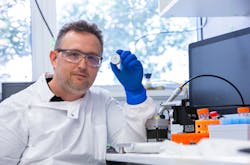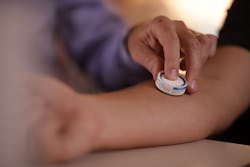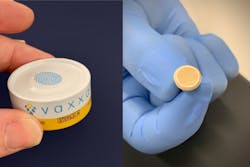Vaccine Patch Protects Against COVID-19 With a Single, Pain-free “Click”
For most people, getting a needle is more of an annoyance than a fear. But for some, the fear of medical procedures involving injections or hypodermic needles can be extreme.
An estimated one in 10 people struggle with trypanophobia, also known as “needle phobia.” It matters because vaccine injections campaigns are negatively affected by these stress-related responses. But while people delay or refuse vaccines for various reasons, the fear of needles need not be one of them.
One way to cope is to find a way to get treatment without injections. A needle-free COVID-19 vaccination is in development at the University of Queensland, where scientists developed a “patch” to administer a U.S.-developed vaccine candidate in mice.
The University of Texas Hexapro vaccine candidate—delivered via the UQ-developed and Vaxxas-commercialized high-density microarray patch (HD-MAP)—provided protection against COVID-19 disease with a single, pain-free “click” from a pocket-sized applicator.
The patch is touted as being more user-friendly than the needle. “You simply ‘click’ an applicator on the skin, and 5,000 microscopic projections almost-imperceptibly deliver vaccine into the skin,” said Dr. David Muller, from UQ’s School of Chemistry and Molecular Biosciences.
The vaccine, dry-coated on the patch, is thermostable and produced strong immune responses that were shown to be effective when the mice were exposed to SARS-CoV-2 (the virus that causes COVID-19), according to Muller. “When the Hexapro vaccine is delivered via HD-MAP applicator—rather than a needle—it produces better and faster immune responses,” he said.
Muller noted that it also neutralized variants of the coronavirus, including the U.K. and South African variants.
The UQ researchers, together with Vaxxas, are looking for funding opportunities to accelerate to clinical trials as soon as possible. Muller said the benefits of delivering the high-density microarray patch could effectively assist the global vaccine rollout effort, “particularly for billions of vulnerable people in low- and middle-income countries.”
For one, it can be self-administered. In addition, it does not have the cold chain requirements of some of the current options. When dry-coated on a patch, the vaccination by HD-MAP remains stable for at least 30 days at 25°C and one week at 40°C.
The research is published in Science Advances.
About the Author

Rehana Begg
Editor-in-Chief, Machine Design
As Machine Design’s content lead, Rehana Begg is tasked with elevating the voice of the design and multi-disciplinary engineer in the face of digital transformation and engineering innovation. Begg has more than 24 years of editorial experience and has spent the past decade in the trenches of industrial manufacturing, focusing on new technologies, manufacturing innovation and business. Her B2B career has taken her from corporate boardrooms to plant floors and underground mining stopes, covering everything from automation & IIoT, robotics, mechanical design and additive manufacturing to plant operations, maintenance, reliability and continuous improvement. Begg holds an MBA, a Master of Journalism degree, and a BA (Hons.) in Political Science. She is committed to lifelong learning and feeds her passion for innovation in publishing, transparent science and clear communication by attending relevant conferences and seminars/workshops.
Follow Rehana Begg via the following social media handles:
X: @rehanabegg
LinkedIn: @rehanabegg and @MachineDesign



